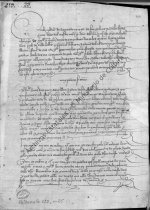Anyone done any research into this one? Marx, in the Florida listings of "Shipwrecks in the Americas", says simply: " a caravel that was part of the expedition of Don Lucas Vasquez de Ayllon, which sailed from Spain in 1524, was lost near Cape St. Helen and natives massacred all of its two hundred survivors".
Lee Spence (and most early authorities) state that the wreck occured at the mouth of the "River Jordan".
Here is where the fun begins. English explorer William Hilton identified the Jordan in 1662 as being the Combahee river in present day South Carolina. Others believe the Jordan was actually the Cape Fear River in North Carolina. Spence, in "Shipwrecks, Pirates and Privateers", argues that the Jordan is the confluence of the Ashley and Cooper rivers that form what is now Charleston Harbor. The University of South Carolina's Maritime Research Division became convinced that the Jordan is the present Santee River. Their rationale, (somewhat unconvincing to me), is explained in the Dec. 2006 issue of Legacy under the title " A Survey for Lucas Vazquez de Ayllon's Lost Capitana". They magged a good portion of the entrance to Winyah Bay after the storm season of 2005-2006 but found no trace of the ship in question. Anyone heard any "tales" of early Spanish shipwreck artifacts on the Beaches of North or South Carolina? If this topic has been discussed in this forum in the past, I apologize. Just looking for a little input from the experts out there...
Lee Spence (and most early authorities) state that the wreck occured at the mouth of the "River Jordan".
Here is where the fun begins. English explorer William Hilton identified the Jordan in 1662 as being the Combahee river in present day South Carolina. Others believe the Jordan was actually the Cape Fear River in North Carolina. Spence, in "Shipwrecks, Pirates and Privateers", argues that the Jordan is the confluence of the Ashley and Cooper rivers that form what is now Charleston Harbor. The University of South Carolina's Maritime Research Division became convinced that the Jordan is the present Santee River. Their rationale, (somewhat unconvincing to me), is explained in the Dec. 2006 issue of Legacy under the title " A Survey for Lucas Vazquez de Ayllon's Lost Capitana". They magged a good portion of the entrance to Winyah Bay after the storm season of 2005-2006 but found no trace of the ship in question. Anyone heard any "tales" of early Spanish shipwreck artifacts on the Beaches of North or South Carolina? If this topic has been discussed in this forum in the past, I apologize. Just looking for a little input from the experts out there...






